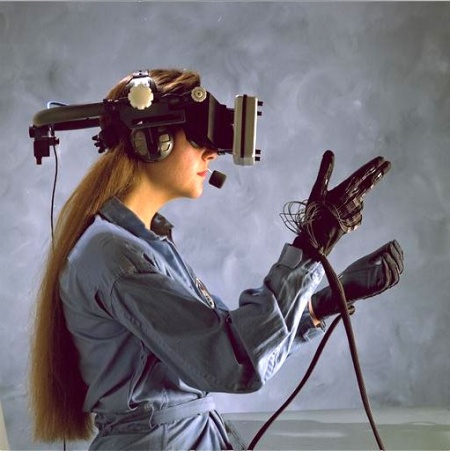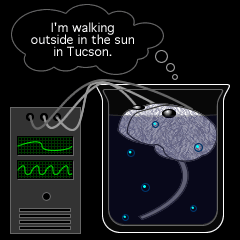Virtual Reality, Cyberspace und Cyborgs
CAVE (Computer Anminated Virtual Environment)
Unplugged! The Organic Cyborg’s Dilemma
Frank Boccia: The Cyborg's Dilemma: Embodiment in Virtual Environments
Ray Kurzweil on The Future of VR
Kip Werking: The Posthuman Condition Kip Werking
"III.iii REALITY
“The apparant world is the only one: the real world is merely a lie.” — Nietzsche, Twilight of the Idols
A third problem I wish to explore in this essay is the question of external reality. Perhaps the first description of this problem is Plato’s allegory of the cave. In this allegory, Plato considers the hypothetical world in which human beings are locked inside of a cave and believe shadows to be real things. The founder of modern philosophy, Descartes, described the same problem by imagining an evil demon who deceives him. Descartes asked how a person can distinguish between the real world and the dream world. Only a few years ago, the character Morpheus from the Hollywood film The Matrix, inspired by Plato and Descartes, asked the same question. The movie might not have been so successful if it had been released earlier than the end of the twentieth century. Technology has progressed so far that the public was willing to entertain the transhumanist future depicted in the Matrix.
The Matrix presents an explicit image of the problem that Plato and Descartes identified. This image is that of a brain in a vat:
The brain in a vat image shows how vulnerable all of our beliefs about the exterior world are. Light might bounce off of objects in the exterior world and into our eyes conveying information about reality. However, it is also possible that wires stimulate my visual cortex to give this illusion. Both interpretations are perfectly consistent with our perceptions. Furthermore, there is no way to distinguish between the two.
In 2001, two years after the Matrix arrived in theatres, Nick Bostrom contributed another image, together with Plato’s Cave and Descartes’ Demon, to this subject. He calls this work The Simulation Argument [3] The argument attempts to show that:
“at least one of the following propositions is true: (1) the human species is very likely to go extinct before reaching a “posthuman” stage; (2) any posthuman civilization is extremely unlikely to run a significant number of simulations of their evolutionary history (or variations thereof); (3) we are almost certainly living in a computer simulation. It follows that the belief that there is a significant chance that we will one day become posthumans who run ancestor-simulations is false, unless we are currently living in a simulation.”
Note how the image has evolved throughout history. Plato only required the technology of fire. The image of people chained in one place and deceived by shadows strikes one as too implausible to be compelling. Descartes drew attention to dreams. We feel confident, however, that we can distinguish between dreams and reality. Descartes increased the plausibility of his account by considering a global supernatural controller — an evil demon — to deceive us. This deception could be more convincing than that involving shadows or dreams. The brain in a vat image, however, increases the plausibility even further by being naturalistic. The argument that we could be such brains invokes only computers — not demons. Finally, the Simulation Argument presents a reason for thinking not just that such a naturalistic scenario is possible but that in fact one is probable. Perhaps the most telling fact about The Simulation Argument is that the author, Bostrom, founded the World Transhumanism Association together with David Pearce, author of The Hedonistic Imperative.
Consider the article “How To Live In A Simulation” [4] by another contributor to transhumanist philosophy, Robin Hanson. Hanson suggests that, given Bostrom’s premise that we live in a simulation, being entertaining is in our best interest. If our descendents simulated us we need to amuse them to secure our own safety and future. We do not want our descendents to pull the plug. The important — but often unstated — consequence, however, is that the value and significance of human life is diminished. According to Hanson’s argument, humanity might be nothing more than a court jester performing for our cruel descendents. Transhumanist philosophy and future technologies do violence to the fourth anthropocentric conceit.
The Matrix presents another image of the problem that virtual reality technology poses for our sense of reality. This film suggests a distinction between internally consistent and internally inconsistent illusions. Consider the people who live within the Matrix such as Neo. Neo was surprised and alarmed by Morpheus’ revelation that Neo lives within the Matrix. Neo felt surprised because the world within the Matrix does not suggest that technology is sufficiently advanced to create such an illusion. Before Morpheus demonstrated the illusion to him Neo never felt troubled by the prospect of Plato’s Cave or Descartes’ Demon. Consider, however, the people who live in Zion and regularly enter the Matrix. These people do not find the existence of global illusions surprising at all. The citizens of Zion know many people, specifically those trapped in the Matrix, who are victims of such an illusion. Now suppose that someone suggested that Zion itself is a global illusion — a Matrix within a Matrix (MWAM) — without demonstrating the truth of his claim. The citizens of Zion can no longer afford Neo’s incredulity at such mere possibilities. This dilemma would cause the Zionites no small amount of anxiety. Yet, the film never depicts Zionites as being particularly troubled by this possibility.
We can immediately note, however, that this distinction between internally consistent and inconsistent illusions is unwarranted. This is so because any and every illusion is consistent with the notion of brain in vat scenarios. There is nothing that constrains the scientist who manipulates the brain from creating illusions in which global illusions cannot happen. For example, such an illusion need not be like Zion, in which the notion of global illusions are presented as feasible. The scientist may just as well create the illusion that you live in ancient Greece with Plato or in Holland with Descartes. The impression that some, such as those in the Matrix, are the victims of illusions, whereas others, such as those in Zion, are not, does not protect one from this dilemma. The citizens of Zion may just as well be trapped within a MWAM. These citizens ought to wonder whether or not their world is an illusion. So should we.
Considering the previous examples one can see how the Matrix did not present the strongest case against the fourth anthropocentric conceit. The citizens of Zion are never shown to be themselves the victims of illusions. Moreover, the controllers of the Matrix only manipulate their victims’ sense of the external world. The controllers might just as well alter their moral intuitions, as the creator of HS3 did, or decision processes, as future police might. They could manipulate their memories. The Matrix suggests, but does not present, the possibility of human beings that are victims of multiple layers of virtual reality and repeated memory and moral intuition wipes. Such a posthuman future threatens to create a philosophical crisis for the human race. To show that this crisis is already beginning to happen consider this quote from a recent news story with the headline “Matrix makes its way into courtrooms as defense strategy,” [5].
“It’s taking people a little further into the future. For people who are already confused between fantasy and reality, it gives them a framework to articulate it,” she said. “People who are already on the edge, it can be argued, can be set off by these types of movies.”
The article describes how Hamilton, Ohio resident Tonda Lynn Ansley was found not guilty by citing an insanity defense. Ansley claimed she was inside of the Matrix. Vadim Mieseges from San Francisco also successfully defended himself at his murder trial by claiming he was inside of the Matrix. Joshua Cooke from Oakton, Virginia argued similarly. Even Lee Boyd Malvo, one of the Washington D.C. snipers, wrote “free yourself of the matrix” while in jail.
I am not claiming that these situations are common or that these people are sane. Moreover, I agree that suspects probably find the Matrix defense attractive whether or not they believe what they say. However, I want to note that before future technologies and ideas made the Matrix plausible and popular, nobody cited this defense. I submit that these cases are merely the beginning of a future philosophical crisis. Although we can perhaps afford to ignore this dilemma, posthumans will not have this luxury. They will find The Human Condition by Magritte to be especially moving for that painting depicts the posthuman condition as well." (Kip Werking)

